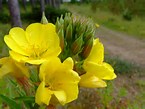



- EVENING PRIMROSE OIL
- Latin Name
Oenothera biennis
O.glazioviana
(0.lamarkiana, O.riparia
Family: Onagraceae - ETYMOLOGY
Evening primrose is also kown as King's Cureall. Oinotheras was the Greek name for this plant and biennis is the Latin for biennial. Glazioviana is after the botanist Glaziou (1828-1906). Riparia means the riverbank. - It is an herbe good as wine to make the heart merry. Of such virtue is this herbe that if it be given to the wildest beast that there is, it will tame the same and make it gentle. (Pliny (quoted by Earle 1991)
- It opens obstructions of the liver and spleen, provokes urine, is good for the dropsy if infused in common drink. (Culpepper 1650)
- THE PLANT AND ITS ENVIRONMENT
Native to North America, the evening primrose was introduced into Europe in 1619, and is now common in the Mediterranean: it is cultivated also in the UK. It has golden-yellow ephemeral flowers which burst into bloom in early evening and soon die, leading to the formation of pods containing tiny seeds (similar in size to mustard seed) from which the oil is obtained. The following evening the next circle of flowers blooms and so they progress to the tip of the stem. It can grow almost anywhere - by riverbeds, on mountains, by seashore and even in the desert. - THE OIL
Like borage oil, evening primrose oil is highly unsaturated (the seed contains up to 25% of an oil rich in unsaturated fatty acids) and is therefore more reactive and less stable than most other oils. It is yellow in colour and oxidizes on exposure to air and light, a process which is accelerated in the presence of heavy metals. It must be remembered that GLA is very fragile and can be rapidly destroyed by light, heat, humidity, and the oxygen in the air. For this reason air should be excluded and the oil stored in a cool dark place. - METHOD OF EXTRACTION
Evening primrose oil is expressed from the seeds.
| Principal Constituents | Based on | Content - % | |
| Saturated fatty units | |||
| C16:0 | palmitic acid | 6.5 | |
| C18:0 | stearic acid | 1.3 | |
| C20:0 | arachidic acid | 0.3 | |
| Typical saturated fatty acid unit content | 8 | ||
| Monounsaturated fatty acid units | |||
| C20:1 | eicosenoic acid | 0.2 | |
| Typical monounsaturated fatty acid unit content | 0.2 | ||
| Polyunsaturated fatty acid units: |
| C18:2 | linoleic acid | 72 (65-75) | |
| C18:3 | alpha linolenic acid | 0.2 | |
| C18:3 | gamma linolenic acid | 9.5 (8-10.5) | |
| Typical polyunsaturated fatty acid unit content | 80 | ||
| Physical Properties |
| Acid Value | 1.0 max. |
| Specific gravity | 0.923 |
- Folk-lore and traditional uses
Native North Americans made an infusion of the seeds to be used for healing wounds. They also used the leaves and roots. In Europe's past, evening primrose has rarely been used for medicinal purposes, but the plant was described by the English herbalist John Parkinson in 1629. - Therapeutic properties - internal use
Gamma-linolenic acid (GLA) is not known to lower blood cholesterol (Bartram 1996) and is therefore extremely useful in the prevention of heart disease. Both linoleic and gamma-linolenic acids are classified as 'essential fatty acids' - vitamin-like materials which are vital for cell and body function but which cannot be made by the body itself (WHO 1990). - Evening primrose oil is claimed to be useful in treating degenerative disease and is said to reduce blood pressure, inhibit thrombosis, control arthritis, treat atopic eczema (Lovell 1981), decrease hyperactivity in children and help in dealing with alcoholism (by reversing liver degeneration). PMT (Horrobin 1983) and schizophrenia (Barber 1988, Horrobin 1990, Li Wan PO 1991) ( the Schizophrenia Association recommend evening primrose oil, vitamin B3, B6 and C, and zinc on a daily basis).
- It is now thought by some that evening primrose oil is of no real benefit in the small doses usually prescribed, although diabetics have used it to lessen the need for insulin; trials have shown that the oil has significantly improved sensory function in diabetics (Bartman 1996). Atopic eczema treatment using evening primrose oil kills tumor cells in association with a marked increase in free radical generation (Ramesh 1992). The oil is recommended for premenstrual syndrome, but there is contradictory evidence (Collins et al 1993).
- u tube
- Therapeutic properties - external use
useful for dry scaly skin
dandruff conditions
has benefitted those with psoriasis (Ferrando 1986)
helpful for eczema (Kerscher & Korting 1992) - accelerates wound healing
- Cosmetic use
The oil can be used in antiwrinkle preparations at levels of around 20%. Once the triacylglycerol is broken down the GLA is used by the body in the repair and maintenance of skin tissue. - Culinary use
Up to the 19th century the pickled roots were eaten as an aperitif in Germany. All parts of the plant are edible and the boiled young roots may be eaten hot or cold. - Cautionary notes
As has been said, oils rich in GLA units can act as building blocks for powerful hormone-like substances that have far reaching effects on all body organs and processes, so oral intake of the oil for long periods of time is not recommended (Mindell 1991). - There are a few reports of unwanted side effects (headache, nausea, mild diarrhoesa) when taking GLA supplements (Briggs 1986, Horrobin 1990). Chevallier (1996) warns against taing evening primrose oil if suffering from epilepsy.
- Borage oil has been used as an adulterant in order to increase the GLA content.
- Reference: Carrier Oils / Len Price et al
